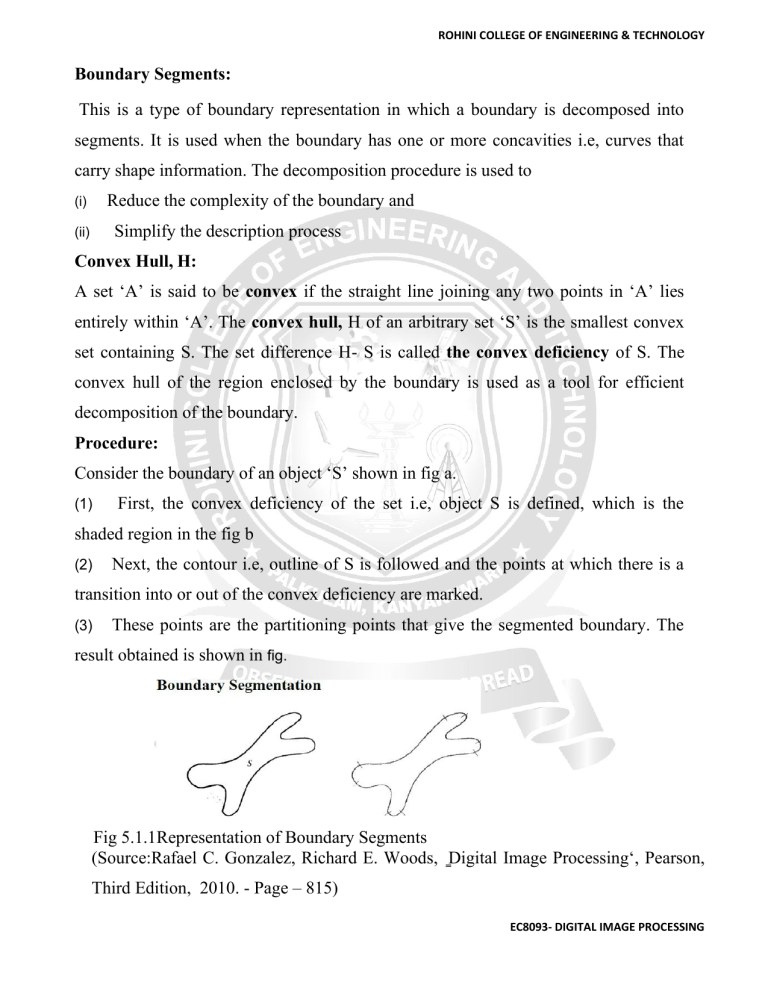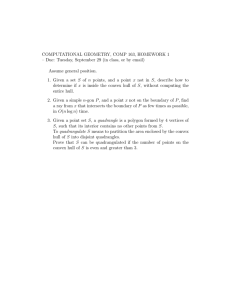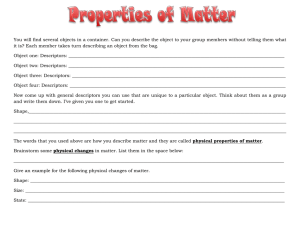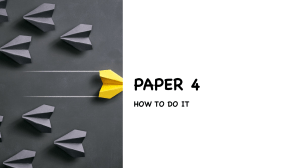
ROHINI COLLEGE OF ENGINEERING & TECHNOLOGY Boundary Segments: This is a type of boundary representation in which a boundary is decomposed into segments. It is used when the boundary has one or more concavities i.e, curves that carry shape information. The decomposition procedure is used to Reduce the complexity of the boundary and (i) Simplify the description process (ii) Convex Hull, H: A set ‘A’ is said to be convex if the straight line joining any two points in ‘A’ lies entirely within ‘A’. The convex hull, H of an arbitrary set ‘S’ is the smallest convex set containing S. The set difference H- S is called the convex deficiency of S. The convex hull of the region enclosed by the boundary is used as a tool for efficient decomposition of the boundary. Procedure: Consider the boundary of an object ‘S’ shown in fig a. (1) First, the convex deficiency of the set i.e, object S is defined, which is the shaded region in the fig b (2) Next, the contour i.e, outline of S is followed and the points at which there is a transition into or out of the convex deficiency are marked. (3) These points are the partitioning points that give the segmented boundary. The result obtained is shown in fig. Fig 5.1.1Representation of Boundary Segments (Source:Rafael C. Gonzalez, Richard E. Woods, D ̳ igital Image Processing‘, Pearson, Third Edition, 2010. - Page – 815) EC8093- DIGITAL IMAGE PROCESSING ROHINI COLLEGE OF ENGINEERING & TECHNOLOGY Advantages: • The advantage of segmenting a boundary using convex deficiency is that it is independent of the size and orientation of the given region. • The convex hull and its deficiency can also be used for describing a region and its boundary. • Drawback: • Factors like digitalization, noise and variations in segmentation may lead to irregular boundaries of regions. • Such boundaries produce convex deficiencies with small, meaningless components scattered randomly throught out the boundary. • This results in an inefficient decomposition processs. REGIONAL DESCRIPTORS. Regional descriptors are used to describe image regions, that is regions enclosed by boundaries. In practice, regional descriptors are used with boundary descriptors. Some important regional descriptors are: (1)Simple descriptors (2)Texture (3)Topological (4)Moments descriptors of two-dimensional functions Simple Descriptors: The simple descriptors used to describe a region are given below: (1) Area: The area of a region is defined as the number of pixels in a region. This is one of the simplest regional descriptor EC8093- DIGITAL IMAGE PROCESSING ROHINI COLLEGE OF ENGINEERING & TECHNOLOGY (2)Perimeter: The perimeter of a region is defined as the length of its boundary. The perimeter and area used as descriptors when the size of a region is fixed (3)Compactness: - The compactness of a region is defined as (perimeter)2/area. -Compactness is a dimensionless quantity and therefore it is not sensitive to uniform scale changes. - It is also insensitive to orientation and thus the error introduced by rotation of a digital region can be avoided. - Its value is minimum for disk — shaped regions. (4) Other Measures: Some other simple measures for describing a region are: (i)Mean and median of the gray levels (ii) Minimum and maximum gray-level values (iii)Number of pixels with values above and below the mean. TOPOLOGICAL DESCRIPTORS: Topology is defined as the study of properties of an image which are not affected by any deformation such as stretching, rotation etc. These properties will change only when there is tearing or joining i.e. folding of the image. Therefore, they are also called rubber — sheet distortions. Using such properties to describe an image or region is known as the topological description. Descriptors Used: Some of the topological descriptors used to describe a region are: • Number of holes in the region • Number of connected components of the region etc. EC8093- DIGITAL IMAGE PROCESSING ROHINI COLLEGE OF ENGINEERING & TECHNOLOGY Example: Consider the region shown in fig. Let its topological descriptor is defined by the number of holes in the region. Fig.5.1.2Example for topological descriptor (Source: Rafael C. Gonzalez, Richard E. Woods, D ̳ igital Image Processing‘, Pearson, Third Edition, 2010. - Page – 823) This property will not be changed if the figure is stretched or rotated. It will be affected only if the region is torn or folded. Thus, some additional features are provided by the topological descriptors which are useful to characterize the regions. - The compactness of a region is defined as (perimeter)2/area. -Compactness is a dimensionless quantity and therefore it is not sensitive to uniform scale changes. - It is also insensitive to orientation and thus the error introduced by rotation of a digital region can be avoided. - Its value is minimum for disk — shaped regions. (5) Other Measures: Some other simple measures for describing a region are: (i)Mean and median of the gray levels (ii) Minimum and maximum gray-level values (iii)Number of pixels with values above and below the mean. EC8093- DIGITAL IMAGE PROCESSING



